Use of Shared Activity, Language and Drawing to Understand the Rain Cycle
Vygotsky (1962; 1978) believed that young children construct meaning through shared activity. In a shared activity, two or more people must communicate with each other by speaking to each other or by drawing or writing something, and that is shared with others either in the process or on completion. Thus, language plays a key role in meaning making.
The meaning each child makes out of this discourse may be different as it is based on the child’s prior experience and knowledge and also what she understands from the language used. The adult can provide scaffolding by talking to the child about her oral or written or drawn expression. Talking also shows the child gaps in her thinking, which they can then rework.
The following anecdote is from the pre-primary class in Kamala Nimbkar Balbhavan (KNB), a Marathi-medium school of Pragat Shikshan Sanstha. KNB is an unaided school, which attempts to enroll children from all walks of life. This allows for a healthy blend of ideas and experiences in the classroom.
The pre-primary classes have a strong play-base where a great deal of doing, drawing, writing and talking happens. The theme for the beginning of the year was ‘rain’ as the school reopens in the monsoon, after summer vacation.
The teachers talked to the children about their ideas of how it rains. Some children talked about rain coming down from the sky. Others talked about clouds. They had no idea how the water goes up into the clouds.
Then the teacher put two pots, one with hot water and the other with cold water, in front of the children.
T: Feel the water in this pot. How is it?
C1 (dips his hand in the water): Cold.
T: Right. We will put a blue card near this pot to say it is cold.
T (points at the other pot): Now feel the water in this pot.
C2 (dips her hand in the water): Hot.
T: Right. We will put a red card near this pot to say it is hot.
T: Now let us cover both the pots.
After a few minutes...
T: Let us now remove the covers.
C1 (removes the plate covering the pot of hot water): This plate has water on it.
C2 (removes the plate covering the cold water pot): And this doesn’t.
T: Right. (Points at the hot water pot) How do you think the water went up to the plate on this pot?
C3: Vapor. I have seen vapor come out of water when mother is making tea.
T: That is right. The vapour is light and therefore goes up and touches the cold plate and becomes water again.
After this experiment, the teacher showed them a picture of the rain cycle and explained the process:
- Water in rivers, lakes and the sea and reservoirs evaporates due to the heat of the sun.
- This water vapour makes clouds.
- When the clouds come in contact with cold weather, they make rain.
Then children were given time to talk and draw pictures and write with invented script. They read this out to the teachers, who transcribed the stories exactly as the children told them. There was no time limit for writing.
The teachers talked to the children about their pictures and writing—here we give you some examples of how teachers supported children’s meaning-making process through talk.
T: How are clouds formed?
C1: The sun heats up the water and it becomes vapour. The vapour forms clouds.
C2: There are white clouds. They become black with vapor.
T: How does the water vapour go up?
C1: The clouds take a deep breath.
T: When does it rain?
C1: When the sun hides behind the clouds.
C:2 When the clouds become cold.
T: If the clouds are formed on the sea, how does it rain in Phaltan?
C: The clouds go up. Then they travel like this… (Moves her hand horizontally). Then it comes to Phaltan. Then it rains.
T: You mean horizontally (also moves hand horizontally)?
C: Yes. Horizontally.
T: Will it rain today?
C: No.
T: Why?
C: Because the sun is not shining today. (The child feels that evaporation of water, cloud formation, followed by rain is a process of quick succession.)
All the children drew pictures and wrote their stories.
Janhavi drew a picture (see Figure 1) that showed the rain-cycle at the bottom of the page and a bigger story in which there was a storm and a fallen tree (there had recently been a big storm in the town, which had left many trees uprooted). There were two square water bodies from which water vapour coursed upwards in continuous lines. They were going into the clouds and making them dark. She showed the rain in broken lines coming down from the clouds. She started writing her story on the same page and finding the space inadequate, took another page. Being an emergent writer, her notion of ‘writing’ was to use the few symbols she had learned until then to express her thoughts. She repeats the symbols she had learnt thus far in a haphazard manner, the letters do not make meaning, but she has written longish words with lines on top (shirorekha). And after writing, she was able to tell a lucid story about it. In her words: “Water evaporated due to the sun’s heat. The vapour became clouds. Then it rained. There was a storm. A tree fell in the storm. It started raining in the birds’ nests. Then the nests also fell down. The sparrows also fell down and then the sun came up again.”
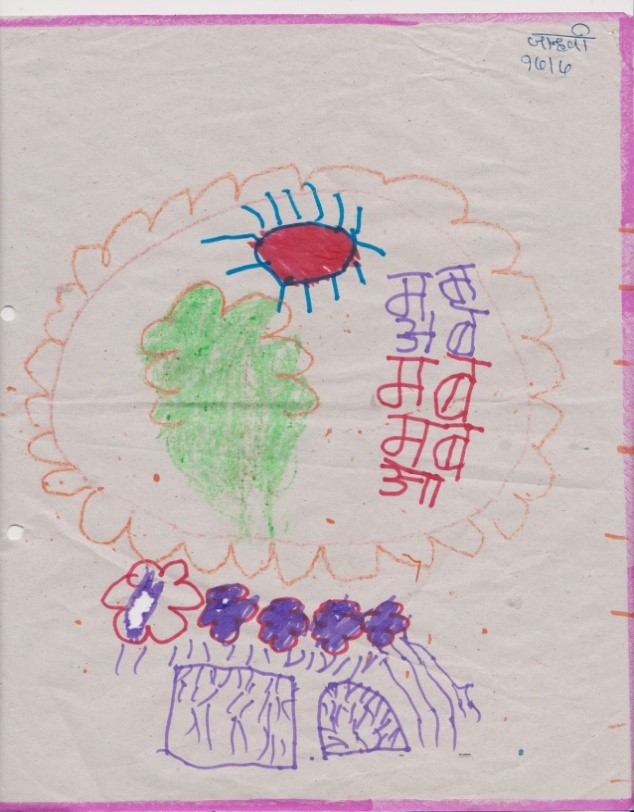
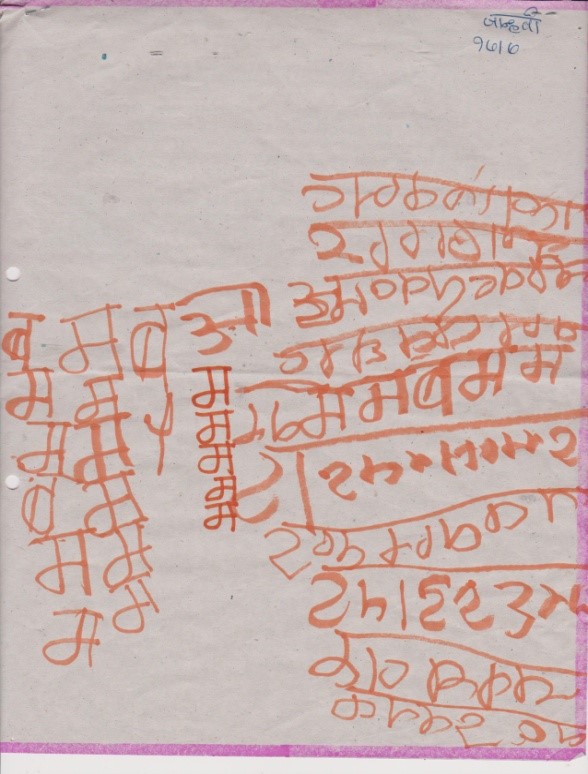
Durva drew a large body of blue water with trees at the bottom of the page and the sun and clouds up in the sky (see Figure 2). Her picture has two more water bodies on top, with blue vapour going out. She wrote a few letters under the picture. Explaining her writing, she said, “The sun was up in the sky. The water was down below. The water down below became hot with the sun. The water turned into vapor and it went into the clouds. They met cold air and it started raining.”
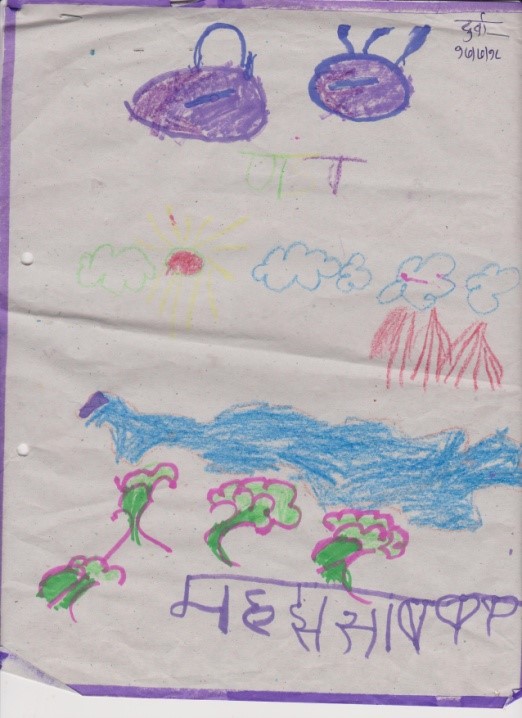
Kranti drew an elaborate picture showing a house and trees, clouds with water vapour going up, and rain pouring down from them, a sun and a rainbow (see Figure 3). Like the other children, she wrote down the aksharas she knew next to it, and explained it thus, “It was morning. The sun came out. The water in the river became hot and its vapor went into the clouds. Then the clouds felt cold and it rained. After the rain, the sun’s rays fell on a house. The shadow of the sun fell on the house.”
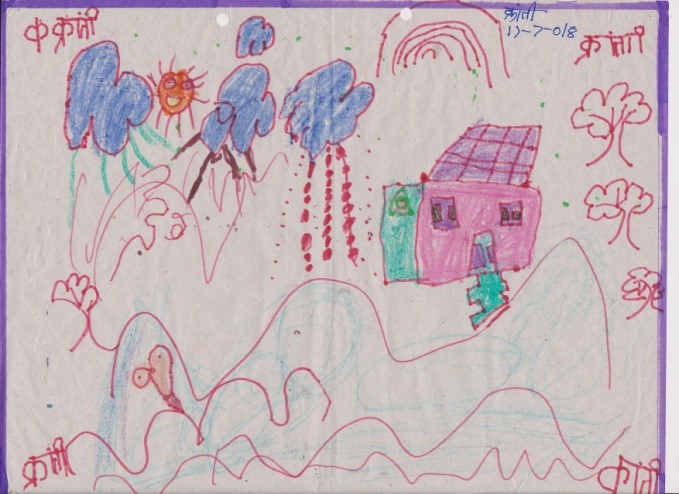
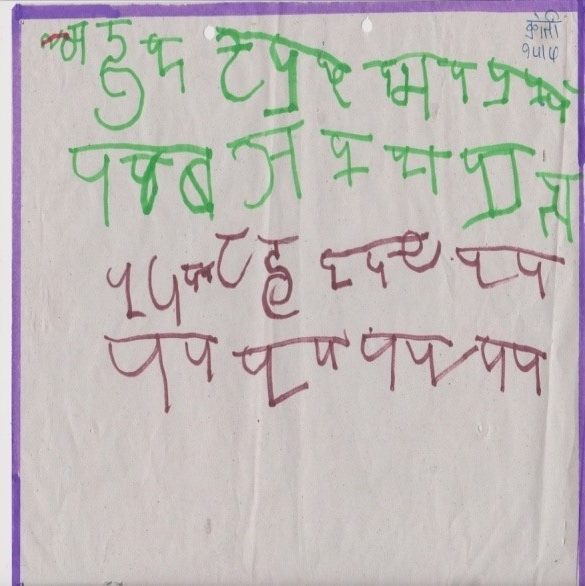
Let us look at what was happening in this class of 5- and 6-year-olds. The teacher wished to introduce the concept of the ‘cycle of rain’. After explaining the cycle with a picture and an experiment, the children were asked if they would like to talk or draw or write about the rain cycle. Some children wanted to talk to the teacher first. Others took art material and started discussing among themselves and drawing. Some children wanted to discuss the pictures with the teacher, while others went straight into writing. Some put the pictures in the “incomplete” basket and completed their task over the next few days.
The teacher’s role was to listen and ask questions to clarify things. Children talked and explained their pictures or read their stories. The whole process took a week. Thus, meaning making was a complex task that took time and repeated movements between talking, drawing, writing and talking again. It is interesting to see that each child expressed meaning a unique way. Each child also added her own experience of rain to the rain cycle.
The shared activity provided the supports necessary for the child’s development of meaning, allowing the child to develop an understanding of a concept through communication of various kinds – talking, drawing and writing. Through this rich use of language, thinking also developed. The children’s understanding of the rain cycle is not scientifically correct. However, with language and continuous discourse through activities and experiments, the children will slowly understand that the rate of evaporation is accelerated due to the heat of the sun. However surface evaporation of water occurs all the time. This journey from naïve theory to scientific theory will also be helped by use of language.
Note: The conversations in the classroom were around the rainy season. It was June and Phaltan had received good rains. As children would have fresh memories of their varied experiences of rain, we thought it best to encourage them to think along these lines. However, as we progressed, it was inevitable that we discuss what we understand to be the water cycle in any science curriculum. Considering this was a group of 5- and 6-year-olds, we thought it best to maintain their understanding of rain and therefore used the term "rain cycle" as we dealt with the concept of the water cycle.